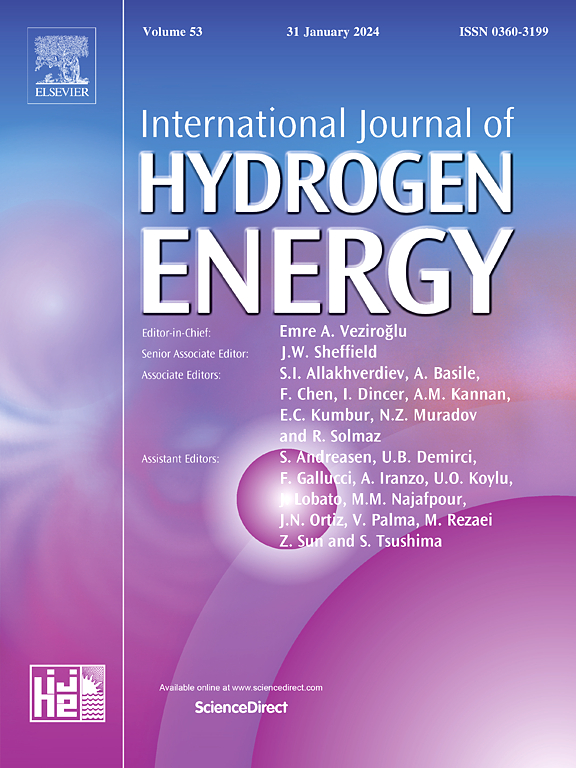通过Janus气体扩散层的高效水管理,提高了电化学氢气压缩机的低湿性能
IF 8.1
2区 工程技术
Q1 CHEMISTRY, PHYSICAL
引用次数: 0
摘要
有效的水管理是低湿条件下高效电化学氢压缩(EHC)的关键。本工作旨在设计和优化具有多层微孔层(MPLs)的气体扩散层(gdl),以增强水的输送和保留。与传统的疏水gdl相比,基于ep40的亲水底物降低了体积阻力,提高了膜的水合性。采用含20% Nafion的MPL可降低接触阻力,进一步促进质子交换膜的水合作用。一种新型的Janus GDL (JM-GDL),结合了PTFE和nion基MPLs,可以实现自发、定向的水输送,并降低膜的欧姆电阻。电化学测试和晶格玻尔兹曼模拟表明,在50%相对湿度和0.3 V条件下,300 s内,采用JM-GDL的mea电流密度为2.8 A/cm2,输出压力为1.0 MPa。这种方法显著提高了EHC性能,为低湿度环境下的先进GDL设计提供了战略见解。本文章由计算机程序翻译,如有差异,请以英文原文为准。

Enhanced low-humidity performance of electrochemical hydrogen compressors through efficient water management with Janus gas diffusion layers
Effective water management is crucial for high-performance electrochemical hydrogen compression (EHC) under low-humidity conditions. This work aims to design and optimize gas diffusion layers (GDLs) with multilayer microporous layers (MPLs) to enhance water transport and retention. An EP40-based hydrophilic substrate reduces bulk resistance and improves membrane hydration compared to conventional hydrophobic GDLs. Incorporating a Nafion-based MPL with 20 % Nafion content lowers contact resistance and further boosts proton exchange membrane hydration. A novel Janus GDL (JM-GDL), combining PTFE- and Nafion-based MPLs, enables spontaneous, directional water transport and reduces membrane ohmic resistance. Electrochemical tests and Lattice Boltzmann simulations demonstrate that MEAs with JM-GDL achieve 2.8 A/cm2 current density and 1.0 MPa output pressure at 50 % relative humidity and 0.3 V within 300 s. This approach significantly improves EHC performance, providing strategic insights for advanced GDL design in low-humidity environments.
求助全文
通过发布文献求助,成功后即可免费获取论文全文。
去求助
来源期刊

International Journal of Hydrogen Energy
工程技术-环境科学
CiteScore
13.50
自引率
25.00%
发文量
3502
审稿时长
60 days
期刊介绍:
The objective of the International Journal of Hydrogen Energy is to facilitate the exchange of new ideas, technological advancements, and research findings in the field of Hydrogen Energy among scientists and engineers worldwide. This journal showcases original research, both analytical and experimental, covering various aspects of Hydrogen Energy. These include production, storage, transmission, utilization, enabling technologies, environmental impact, economic considerations, and global perspectives on hydrogen and its carriers such as NH3, CH4, alcohols, etc.
The utilization aspect encompasses various methods such as thermochemical (combustion), photochemical, electrochemical (fuel cells), and nuclear conversion of hydrogen, hydrogen isotopes, and hydrogen carriers into thermal, mechanical, and electrical energies. The applications of these energies can be found in transportation (including aerospace), industrial, commercial, and residential sectors.
 求助内容:
求助内容: 应助结果提醒方式:
应助结果提醒方式:


